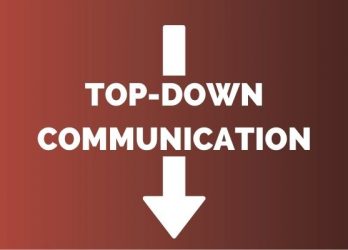Last updated on March 7, 2024 at 10:51 am
Not all executives are good communicators. Whether it’s because they haven’t been trained, they’re out of touch with the employee voice, or because they aren’t good at public speaking, there are many reasons why the C-Suite can miss the mark when addressing your company. But that’s where internal comms professionals shine, right? It’s up to you to train your executives and give them the right insights and tools to strike the right chord. But we know that can be a challenge. How do you tell your executive team that they need to change the way they communicate? How can you embrace different leadership communication styles? These 3 executive communication coaching tips will help.
What Are the Communication Styles in Leadership?
Before we talk about how to coach your executive team on communication, let’s talk about leadership communication styles. There are many communication styles, but the effectiveness of each depends on who is being communicated to. This is why your executives need to be well-versed in multiple styles, not just what comes naturally to them.
A few of these communication styles are:
- Coaching. This is an empowering style of communication where the leader lets their employees take the lead. Think of a coach as a guide. They won’t tell you want to do directly, but they won’t leave you hanging either.
- Mentoring. Mentors take a more hands on approach and share their experiences to give sage advice. They want what’s best for who they are communicating with and want to share their mistakes and learnings to help their employees act from a place of knowledge.
- Delegating. Delegation is key to learning. This style of communication embraces trusting your team to get things done by handing over the work to others. This is the opposite of a micro-manager who has their fingers in every project and demands they get final approval on everything.
- Directing. A directing style is also more hands-on where you tell a person what to do, but also give them instructions. You’ll see many leaders have this style. They want things done a certain way. And although they’re technically delegating, this comes with far more instructions and less autonomy.
Naturally, no one uses only one style. Leaders will often employ several of these. The key is for your executives to adapt their style to a situation or individual. Some want more direction, and others want more mentorship.
What Are the 4 Elements of Executive Coaching?
Now that we know about communication styles, we can talk about the elements of executive communication coaching. Understanding these key elements will help you get through to your executive team and show them how they can be more effective communicators.
There are four stages of executive coaching:
- Awareness. Your senior leaders might not be aware of how they come across and how they communicate. This first stage is about showing your leaders how they communicate and how that is or isn’t achieving your communication goals. This takes a delicate approach because you don’t want to offend your leadership team. So, remember to tie it back to goals and express how not all styles work the same way. This might even be as simple as suggesting a different medium for sharing communication (e.g. leadership videos).
- Analysis. The next step is to conduct an analysis. This includes talking with the leader about their goals and expectations and then doing some research. How have the existing methods for communication fallen short of these goals? What are the sentiments towards this leader and how they address the company or their team? What are the leader’s strengths and weaknesses with communication? All this data will help you create your action plan.
- Action. Like with any goal, you want to create a specific, achievable action plan. It’s not effective to simply tell leaders to communicate better or more empathetically. You have to break down exactly what tactics should be used to get there. This can include new behaviors, learning new skills, trying new mediums for communication, etc.
- Achievement. The last step is to start sharing the results. Show how all these changes have been making a real difference. This will help reinforce the importance of effective communication and make the habits stick.
Executive Communication Coaching Tips
So, how do you ensure that your executive communication coaching strikes the right chord with leadership and helps you get results? These 3 tips will help.
1. Use data to make the case for executive communication coaching.
Historically, communications professionals have relied on anecdotes and instincts when assessing the effectiveness of communication. Part of that is not having the right tools or channels for measurement, and true internal comms ROI is hard to prove. But IC pros need to become better at measurement and analytics because data is the way to improve executive comms.
If you can provide your executive team with real evidence (from employee surveys or focus groups), this makes it easier to prove that there is room for improvement. Although telling someone that their communication style isn’t effective might bruise their ego, if you can tie it back to the success of your company, this will help them overcome hurt feelings.
Data also allows you to be more tactical about how you tell them. Instead of just saying, “Your communication isn’t effective,” you can give specific examples. For instance, the survey might show that employees really just want more communication or transparency. Or they always infer a negative tone in written emails from the CEO even if that wasn’t the intention behind the message.
2. Share why executive communication is so important.
You know that “the why” is one of the most important things to include in internal communication. Employees want to know why a change matters, why a new procedure is so important, and why your company does what it does (your purpose!).
Your executive leaders are the same. You need to show them why their communication is critical. And what happens when they aren’t effective communicators.
If you don’t already have this proof internally, there are many external benchmarks and studies to reference. For instance, Edelman’s Annual Trust Barometer is full of valuable insights on the value of executive comms. Here’s one example:
“Employees who have trust in their employer are far more likely to engage in beneficial actions on their behalf. They will advocate on behalf of their organization, are more engaged, and remain far more loyal and engaged.”
Another great resource is Harvard Business Review. You’ll find hundreds of examples of why leadership communication is vital to any company’s success. Whether it’s showing the correlation between effective executive communication and employee retention and productivity or how employees value transparency and real-time access to information, many reputable resources will help you make your case.
3. Conduct an internal communication audit, focusing on executive comms.
Steps one and two will help you explain why you need to incorporate leadership communication into your internal communications plan. But you then need to create a meaningful action plan that is rooted in your company goals.
A good way to create actionable plans is to start with an audit of your internal communications. This will let you learn:
- What executive communications are being shared on each of your communication channels?
- What groups of employees are missing out on certain leadership messages?
- How often leaders are communicating?
- Which leaders are seeing the best results on their communications?
- Which channels and message mediums are most effective for executive messages?
Once you have the results of your audit, you can show leaders where the gaps are in your strategy. This helps you go after the low hanging fruit first. Things like making sure all employees, deskless and deskbound, are getting regular updates from leadership or using the right mediums for these messages.
Next Steps
Developing a strategy for executive communications and getting leadership to embrace the plan will significantly impact your organization’s bottom line and the employee experience. Don’t wait to begin developing this strategy. Although the Edelman Trust Barometer says that “my employer” is still the most trusted source of information, if we don’t improve our executive comms strategy now, we may risk losing employee trust.
All eyes are on the C-Suite and the CEO to speak out publicly about critical issues. If we fail to address these internal and external issues, we will have wasted this opportunity to remain the most trusted institution.
About the Author
Amy Jenkins is theEMPLOYEEapp’s Director of Client Strategy & Success. With over ten years of experience working in internal communication, Amy helps our clients create mobile communication strategies that get results.
Subscribe To The theEMPLOYEEapp Newsletter
Comments are closed.







